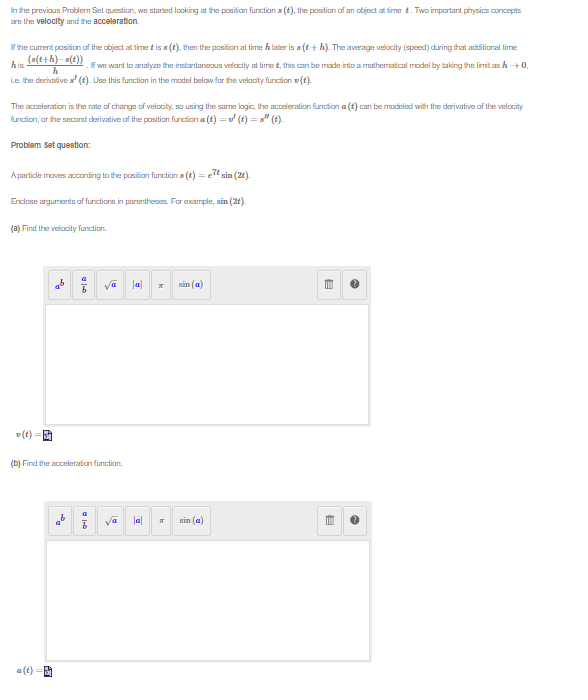In the previous Problem Set question, we started looking at the position function (), the position of an object at fimet. Two important physics concepts are the velocity and the acceleration. If the current position of the object at time t is s (t), then the position at time later is s(t+h). The average velocity (speed) during that additional time his ("(t+h)-a(t)) If we want to analyze the instantaneous velocity at time t, this can be made into a mathematical model by taking the limit as h→0. L.e. the derivative a' (t). Use this function in the model below for the velocity function (t). The acceleration is the rate of change of velocity, so using the same logic, the acceleration function a (1) can be modeled with the derivative of the velocity function, or the second derivative of the position function a(t)=√(t)=s" (t). Problem set question: =e7t sin (21). A particle moves according to the position function (t) = Enclose arguments of functions in parentheses. For example, sin (21).
In the previous Problem Set question, we started looking at the position function (), the position of an object at fimet. Two important physics concepts are the velocity and the acceleration. If the current position of the object at time t is s (t), then the position at time later is s(t+h). The average velocity (speed) during that additional time his ("(t+h)-a(t)) If we want to analyze the instantaneous velocity at time t, this can be made into a mathematical model by taking the limit as h→0. L.e. the derivative a' (t). Use this function in the model below for the velocity function (t). The acceleration is the rate of change of velocity, so using the same logic, the acceleration function a (1) can be modeled with the derivative of the velocity function, or the second derivative of the position function a(t)=√(t)=s" (t). Problem set question: =e7t sin (21). A particle moves according to the position function (t) = Enclose arguments of functions in parentheses. For example, sin (21).
Functions and Change: A Modeling Approach to College Algebra (MindTap Course List)
6th Edition
ISBN:9781337111348
Author:Bruce Crauder, Benny Evans, Alan Noell
Publisher:Bruce Crauder, Benny Evans, Alan Noell
Chapter2: Graphical And Tabular Analysis
Section2.1: Tables And Trends
Problem 1TU: If a coffee filter is dropped, its velocity after t seconds is given by v(t)=4(10.0003t) feet per...
Related questions
Question

Transcribed Image Text:In the previous Problem Set question, we started looking at the position functions (t), the position of an object at time t. Two important physics concepts
are the velocity and the acceleration.
If the current position of the object at time is as (t), then the position at time h later is a (t+h). The average velocity (speed) during that additional time
his
(s(t+h)-s(t)) If we want to analyze the instantaneous velocity at time t, this can be made into a mathematical model by taking the limit as h→0.
i.e. the derivative a' (t). Use this function in the model below for the velocity function ().
h
The acceleration is the rate of change of velocity, so using the same logic, the acceleration function a(t) can be modeled with the derivative of the velocity
function, or the second derivative of the position function a(t) = ✔ (t) =" (t).
Problem set question:
A particle moves according to the position functions (t) = etsin (2).
Enclose arguments of functions in parentheses. For example, sin (2t).
(a) Find the velocity function.
v (t) =
2
(b) Find the acceleration function.
a(t)
|-
|a|
A
|a|
24
T
sin (a)
sin (a)
8
8
~
~
Expert Solution
This question has been solved!
Explore an expertly crafted, step-by-step solution for a thorough understanding of key concepts.
Step by step
Solved in 2 steps

Recommended textbooks for you

Functions and Change: A Modeling Approach to Coll…
Algebra
ISBN:
9781337111348
Author:
Bruce Crauder, Benny Evans, Alan Noell
Publisher:
Cengage Learning

Trigonometry (MindTap Course List)
Trigonometry
ISBN:
9781337278461
Author:
Ron Larson
Publisher:
Cengage Learning


Functions and Change: A Modeling Approach to Coll…
Algebra
ISBN:
9781337111348
Author:
Bruce Crauder, Benny Evans, Alan Noell
Publisher:
Cengage Learning

Trigonometry (MindTap Course List)
Trigonometry
ISBN:
9781337278461
Author:
Ron Larson
Publisher:
Cengage Learning


Algebra & Trigonometry with Analytic Geometry
Algebra
ISBN:
9781133382119
Author:
Swokowski
Publisher:
Cengage

Algebra and Trigonometry (MindTap Course List)
Algebra
ISBN:
9781305071742
Author:
James Stewart, Lothar Redlin, Saleem Watson
Publisher:
Cengage Learning